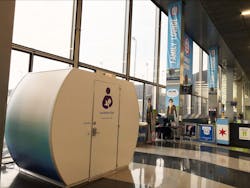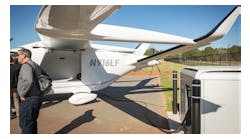As the U.S. prepares for one of the biggest holiday travel seasons in recent years — Mamava, the category creator of freestanding lactation spaces, is ready to support breastfeeding parents on the go. Mamava has released their comprehensive 2022 ranking of lactation amenities in major airports. Within the next two months the number of air travelers is expected to meet, if not surpass, pre-pandemic levels. Travel for parents with children under five is on the rise and knowing which airports support breastfeeding families is critical for travel planning.
With 182 pods across 76 airports, and a free locator app that helps parents find thousands of lactation places, Mamava reports more than 1 million sessions in 2022 and a 68% increase in app downloads. In September alone, there were 40,000 app sessions, an 80% increase over September of last year.
Mamava is transforming the culture of breastfeeding by making it easier for more parents to pump or nurse at work and in public spaces. Mamava’s freestanding lactation pods are intentionally designed with easy-to-clean surfaces and app-enabled access to provide a comfortable and private option to breastfeed or pump. Mamava designs, engineers and assembles their pods in the USA. Mamava pods help airports comply with the Friendly Airports for Mothers (FAM) Act and the Friendly Airports for Mothers Improvement Act. There are now more than 3,000 Mamava pods in all 50 states including airports, malls, hospitals, universities, stadiums, schools, zoos, and corporate enterprises.
"Airports are working hard to elevate the customer experience for young families, and lactation pods offer accessible convenience,”says Sascha Mayer, Mamava's co-founder. "We created this company to make breastfeeding easier for all, and are thrilled that airports share our commitment to support, celebrate, and normalize breastfeeding for traveling parents."
Mamava shares tips for upcoming holiday airplane travel:
Pack light to avoid checking your bag.
A backpack can double as a diaper/pump bag and personal bag. The FDA considers breast pumps a medical device, so they shouldn't count as an additional carry-on. However, each airline treats breast pumps differently, so it’s best to check directly with your carrier before you travel.
Understand TSA guidelines for breast milk.
When it comes to traveling with breast milk (and pumping paraphernalia!), the TSA guidelines can be confusing. Here’s what you need to know:
- Breast milk is exempt from the limited quantity rule of 3.4 ounces.
- Let TSA agents know you’re traveling with breast milk.
- Separate your pump and bottles (empty or full) from other liquids for screening.
- Freeze all your ice or gel packs. Partially melted packs may be subjected to additional screening.
- Breast milk does not need to be X-rayed or opened. If thawed, TSA may opt to test it for explosives, but you have the right to say no. You also can ask the TSA agent to put on a fresh pair of gloves if they handle your bottles or bags of milk.
Consider investing in little conveniences.
- TSA PreCheck. This program can reduce your wait time in security lines.
- Milk Stork. If you’ll be pumping a lot during your trip, and would rather not travel with your milk, Milk Stork will ship it home for you.
Time nursing sessions strategically.
Takeoff and landing tend to be toughest for babies—air pressure changes are hard on tiny ears. Nursing can help.
Play it safe.
Traveling while breastfeeding means taking a few extra precautions to keep things clean. Hand sanitizer and disposable wipes can offer some protection and peace of mind.


